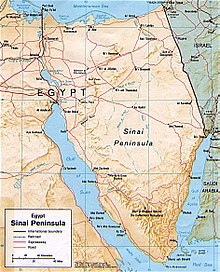Iuntiu
| Iuntiu in hieroglyphics | ||||||||
|---|---|---|---|---|---|---|---|---|
| Old empire |
|
|||||||
| New kingdom |
Iuntiu- (seti) Jwntjw- (stjw) those of the pillars (in the arched land ) or those of the arches |
|||||||
| Iuntiu-seti (top left) as a prisoner of Seti I. | ||||||||
Iuntiu (also Iuntiu-seti ) was the ancient Egyptian name of the nomadic desert people . Herodotus and Strabo called this ethnic group disparagingly troglodytes . Periplus Maris Erythraei contemptuously described them as "fish eaters who live in scattered caves in narrow valleys".
background
etymology
The translation of the name Iuntiu is controversial among Egyptologists . Siegfried Schott sees a derivation from the term "pillar" ( Iun ). Those pillars were used to mark the way to the copper mines on the Sinai Peninsula and could therefore have been used to name the tribes living there. Wolfgang Helck considers the ancient Egyptian word "Bogen" ( Junet ) as a further possibility, which was used in general for the hostile peoples of Egypt .
Predynastic time
The Asian Iuntiu belonged to the tribes of the Arabian desert and the Sinai. In predynastic times , they appeared as enemies of Egypt more often in fighting in the eastern Nile Delta . The Iuntiu tribes living in the Nubian desert were later given the name seti , which referred to Ta-seti and gave its name to the first Upper Egyptian district in the Old Kingdom .
Dynastic time
Since the 1st dynasty , the Egyptians saw the Asiatic tribe of the Iuntiu mostly as rebels who inhabited the area of Wadi Maghara in Sinai. Since Wadi Maghara housed several copper mines, this region was therefore repeatedly the target of Egyptian attacks and could only be brought under control in the 3rd dynasty . Nevertheless, there were repeated uprisings by the Iuntiu; For example, Cheops reported the prostration of the Iuntiu in Wadi Maghara and added the determinative of the defeated enemy to the pictorial representation .
In the further course of ancient Egyptian history, the geographical assignment and meaning changed due to the addition of the name . The term Iuntiu-seti was now mainly a synonym for various Nubian tribes, some of which also served as archers in the Egyptian army.
In the New Kingdom, several uprisings Iuntiu-seti are occupied. On the northern outer wall of the great Karnak temple they are depicted by Seti I as defeated enemies. Whether the other Iuntiu tribes also included the inhabitants of the Libyan desert has not yet been clarified in Egyptology .
See also
literature
- Wolfgang Helck : History of Ancient Egypt; Vol. 1, Section 3 . Brill, Leiden 1981, ISBN 90-04-06497-4

